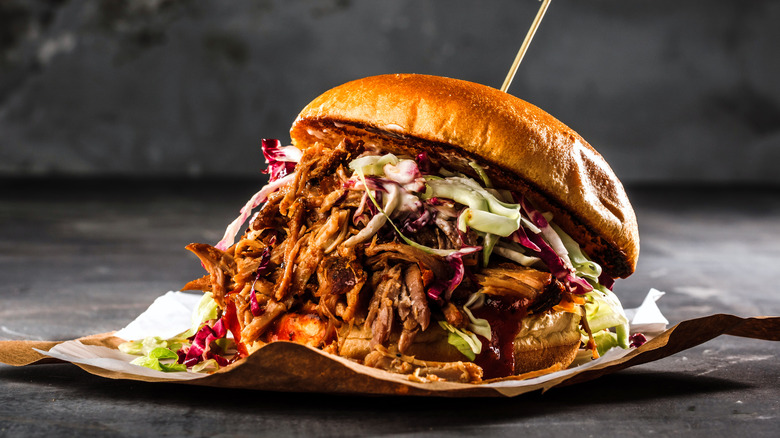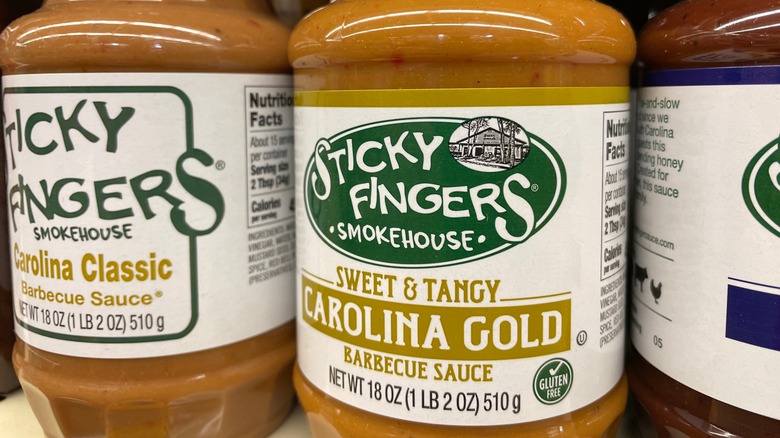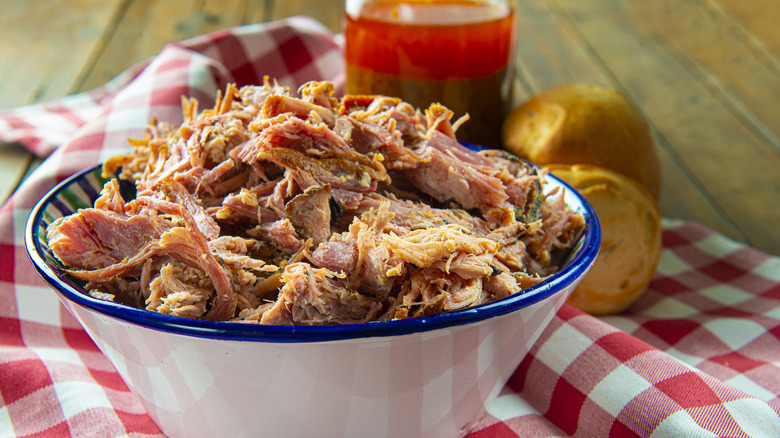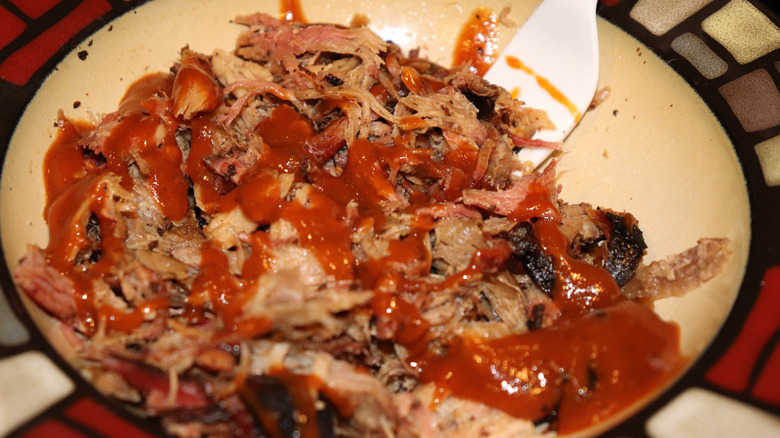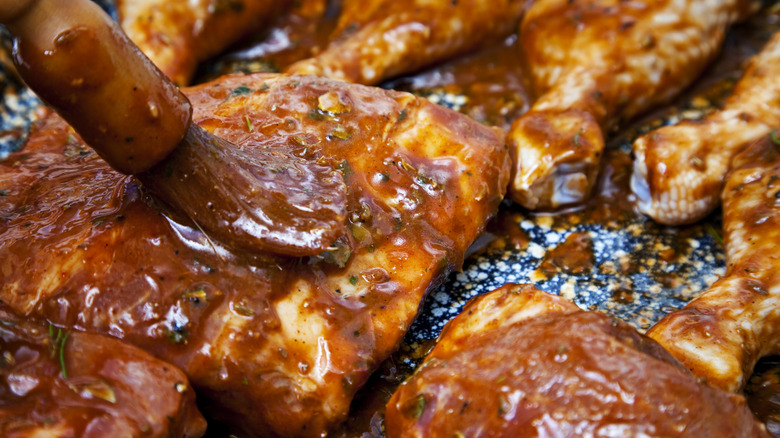The 4 Types Of South Carolina Barbecue Sauce, Explained
For years talk of regional barbecue styles has centered around a few big names like Memphis or Texas, but Southern barbecue aficionados know local differences get even more granular than that, and that's never more evident than in South Carolina, which counts no fewer than four popular barbecue sauces. Carolina barbecue, both North and South, is known for its devotion to pork over beef, from the classic pulled pork to whole pigs on a spit, and it's also one of the most varied regions for how locals like to dress up their meat. Outsiders might already know about South Carolina's unique mustard-based barbecue sauce, which you often see sold nationally by major brands, but that sauce only represents a slice of the Palmetto State.
In the murky regional debates of barbecue, there is a supposed rivalry between North and South Carolina, with the North laying claim to a thinner vinegar sauce. In reality, that sauce is also popular down in South Carolina and makes up another one of the state's four styles. The other two sauces are the least well-known to non-natives but are a little more similar to styles from other parts of the country. There is a slightly sweet and tangy "light tomato sauce," with ketchup, and a darker, heavy tomato sauce that's sweeter, and closer to the thick sauces served in the rest of the country. Taken together they represent an amazing range of tastes and techniques that highlight the diversity of the state.
South Carolina mustard barbecue sauce
This is the barbecue sauce most people think of when they think of South Carolina. Often called Carolina Gold, it's a true standout in the world of barbecue for its yellow color, stemming from its use of mustard as a key ingredient in place of tomatoes or ketchup. The taste for mustard comes from the German immigrants who came to the state in the 18th century. In fact, many mustard barbecue sauce companies are still named for German families. That heritage is also where you get the classic pairing of South Carolina barbecue and pork, as mustard and pork is a standard flavor combo in Germany. Of the four South Carolina sauces, gold is most popular in the central region of the state, and on the Southern coast around Charleston.
Like any barbecue sauce, there is no one recipe for Carolina Gold, but the essential base is yellow mustard and apple cider vinegar. It's also distinguished from other barbecue sauces because it's primarily sweetened with sugar instead of molasses. From there, you're going to see much bigger divisions. Worcestershire sauce is common, and a small amount of tomato flavor from paste or ketchup is often added, but only a bit, it shouldn't overshadow the mustard. The spices can get even more personal, with classics like onion and garlic powder, or cayenne and hot sauce for a little heat. As stated, it's traditionally served with pork barbecue, with pulled pork being the ideal pairing.
Vinegar and pepper barbecue sauce
Shared with their northern neighbors, vinegar and pepper barbecue sauce is most popular in the low country on the eastern coast of South Carolina. Vinegar and pepper sauce might be among the oldest styles of barbecue sauce, as Native American and enslaved Africans' use of vinegar, salt, pepper, and butter to cook whole animals was recorded all the back in the 1700s. Vinegar and pepper sauce is also known as a mop sauce, because it's a thin mix that's brushed on the meat to baste it as it cooks, in addition to being used as a sauce. The tang from the sauce and the smoke from the barbecue are often the only things flavoring the meat in this style, although, if you like, it can also be used as an acidic base before other sauces are added.
Vinegar and pepper barbecue sauce is about as simple as the name would suggest. In addition to vinegar, either apple cider or distilled, it's just salt, black pepper, and red pepper flakes. You can make some adjustments at the margins, adding a little white or brown sugar to even out the sharp bite, or maybe a dash of hot sauce, but the vinegar and pepper sauce is about letting the meat shine. Brush it on pork shoulder, use it with traditional whole hog barbecue, or try it on some pork ribs.
Light tomato barbecue sauce
Head west from the coast along the border of North and South Carolina and you'll start to encounter this slightly thicker, sweeter variation on vinegar barbecue. Like the vinegar and pepper style, this sauce is shared between North and South but is more popular in the western Piedmont regions of the states. It's also known as "Lexington Dip," after the town of Lexington, North Carolina. Like mustard barbecue, it's flavor profile is credited to German influence in the area, as the introduction of mass-produced ketchup in the early 20th century allowed German families to recreate a sweet-and-sour taste that's common in Deutschland. In addition to being brushed on barbecue, it's called a dip because it also gets served as a side with more simple vinegar-brushed meat for diners to dunk in as they see fit.
Fitting in with other Carolina barbecue, this is a very vinegar-heavy sauce. The main change is the addition of ketchup to the vinegar and pepper base, which brings some extra sweetness and makes it a bit thicker, although it's still light compared to other barbecue sauces. Light tomato sauce also has a bit more of a spicy kick than the other South Carolina styles, which it can get from cayenne pepper or hot sauce. Like vinegar and pepper, it can be used as a mop to baste and a sauce. Pork shoulder is the cut of choice with light tomato, served shredded, chopped, or sliced.
Heavy Tomato barbecue sauce
You don't need to visit South Carolina to try heavy tomato barbecue, as it's essentially your classic barbecue sauce as made famous by Kansas City, and that you see bottled and sold across the country. That said, it's the preferred style in the western and southwestern corners of the state. Heavy tomato sauce is sweeter and thicker than the other types of Carolina barbecue, and because of its ubiquity around the nation, it's the most open to interpretation.
Befitting its name, it goes much heavier on the tomato, usually ketchup or tomato sauce, and cuts down on the vinegar. The darker color and sweetness come from molasses and brown sugar. For extra flavor Worcestershire and brown or yellow mustard can add some depth. From there it's all about personal taste, whether you want a little kick from hot sauce, extra sweetness from honey, or smoky flavor from chili powder. Some fresh onions and garlic are also simmered in a pan first before the other ingredients are added and cooked down to thicken.
While this would still be great with Carolina pork, heavy tomato sauce gets paired with everything from beef to chicken. Spread it on ribs, pork, or beef, or serve it with brisket, especially burnt ends. Just make sure to use a light touch when brushing it on, as heavy tomato sauce packs a big flavorful punch, and you don't want to overwhelm the meat you worked so hard on.
